Today I’d like to show you one of my two time-pressure meltdowns from last weekend. This was the worst one, because it caused me to lose a game that I should have drawn and maybe even could have won. And as is often the case, the seeds of my defeat were planted long before the final debacle. Let’s start in this position.
FEN: 5r1k/p3r1p1/3pP1np/1qpB1p1N/5P2/PPQ3PP/K3R3/8 w – – 0 43
I’m White in this position, against a young player named Richard Yi, who is almost but not quite an expert. I had played a positional exchange sacrifice several moves earlier. Initially I probably did not have full compensation for the exchange, but by this point Rybka rates the position as equal. I felt that I had very good chances to win, not just save the draw.
Now let me say something about the time situation. The time control for this tournament was a very strange one that I have never played with before: 40 moves in 2 hours, followed by game in 30 minutes. It’s a strange mix of slow, classical chess with rapid chess. After I’ve gotten past the time control in a regular game, I typically take 5 minutes off to calm my nerves and refocus. But there’s no time for that here! If I take 5 minutes off, I’m already down to just 25 minutes for the rest of the game. (Actually, I did take 5 minutes on my 41st and 42nd moves, without even realizing it.) Meanwhile, my opponent has managed his time much better. He still has an hour left, to my 25 minutes. In a position like this, which is still a complex middlegame, that’s a huge hole for me to put myself into. And what’s more, I took something like 10 minutes on my next move, giving myself just 15 minutes for the rest of the game. That’s the first part of my meltdown. There’s absolutely no way I could afford the luxury of taking that much time.
White has an abundance of choices here. I can move my rook basically anywhere, or I can protect it with Qb2 or Qc2, or I could block Black’s queen attack with 43. Bc4. But more than a move, I need a plan. The only realistic way to try for a win, I thought, is to play for g3-g4. But the trouble is that (aside from the fact that my rook is hanging) I can’t play g4 yet, because Black will trade pawns and then capture on f4. What move would fortify f4 better? The only move I could see was Rf2. I also liked the fact that on f2 the rook controls two squares where Black’s queen could try to invade, e2 and f1. So I finally decided on 43. Rf2?!
The problem with 43. Rf2 is that it is not a very forcing move. It gives Black a chance to fight for the initiative with 43. … a5, which he immediately did. Certainly the first move I should look at, and the first move I did look at, was 43. Bc4! This evicts Black’s queen from b5 before it can become a pain. The reason I decided against this move was that Black can play 43. … Qc6 (which is indeed the computer’s recommendation). Now my response is obvious: I have to play 44. Rd2 to prevent … d5. And here I thought, “But Black can play 44. … Qh1. Ewww.” And there my analysis ended. (See diagram. Actually, the computer wants us to throw in the moves 44. … a5 45. a4 first, and since what follows is all computer analysis, I will defer to its wishes. So here is the position after 44. … a4 45. a4 Qh1.)
FEN: 5r1k/4r1p1/3pP1np/p1p2p1N/P1B2P2/1PQ3PP/K2R4/7q w – – 0 46
Here is the second root cause of my meltdown. When I got to this position in my analysis, I decided I didn’t like it without doing any deeper analysis. And yet this position is full of tactics. You just can’t reach an evaluation until you look at the tactics. Black’s last move allows White to crash through in the center with 46. Rxd6! So, okay, Black will play 46. … Qxh3 and White’s knight is toast, right?
Well, it’s not so clear. I could defend it by Be2 or Qf3, and I have to feel as if Black’s position is looking a bit dicy. But even more to the point, Rybka finds a way for the knight to go out in a blaze of glory. I’ve been itching to sacrifice on g7 (or f6) for about 10 moves, and now it’s finally time! The move 47. Nxg7! is sound, and ensures White at least a draw. The next few moves are completely forced for both sides: 47. … Rxg7 48. Rd7 Rg8 49. e7! (diagram)
6rk/3RP1r1/6np/p1p2p2/P1B2P2/1PQ3Pq/K7/8 b – – 0 49
Kaboom! This pawn move descends on Black like the hammer of Thor. With the threat of e8Q looming, Black is forced to give back the piece with 49. … Nxe7 50. Rxe7 Qxg3! (A nice saving resource, otherwise Black would be lost.) 51. Qxg3 Rxg3 52. Bxg8 Kxg8. The result is a rook-and-pawn endgame that is most likely a draw. (Rybka gives White a token edge of 0.1 to 0.2 pawns.)
So what am I saying? On the one hand I said that I should not have taken 10 minutes on this move. On the other hand it looks as if I’m saying that White should have calculated a variation 10 moves deep. Aren’t these kind of contradictory statements?
Well, no, what I’m saying is that if you’re going to use 10 minutes, you’d better make those minutes count. You’ve got to learn which kinds of positions require concrete tactical analysis and which ones don’t. And if you get to a position with pawns hanging and sacrifices in the air, it is ridiculous to stop and say, “I don’t like it. Too scary.” It may be worth spending those 10 minutes, or at least 5 minutes, to do the analysis and get the evaluation right.
I can’t stress this point enough because it’s a constant source of failure in my games. I take oodles of time, but it’s not really spent the right way. How could I spend 10 minutes on the position and only analyze it two moves deep? You can do that in 30 seconds, it doesn’t take 10 minutes.
Okay, we’re not done yet with the post-mortem dissection of my meltdown. There’s more to come. You may say, what if Black doesn’t go all in with 45. … Qh1? What if he just plays a calm waiting move, like 45. … Qb6 (Rybka’s other top choice)?
FEN: 5r1k/4r1p1/1q1pP1np/p1p2p1N/P1B2P2/1PQ3PP/K2R4/8 w – – 0 46
Now here we get exactly the opposite kind of position from the one we just looked at. This is not a tactical position, there are no pawns hanging, and so there is no point in trying to do deep “I do this-he does that” style analysis. Instead, what’s needed here for White is a plan.
That brings us to the third cause of White’s meltdown. In this position I couldn’t find a plan. It looked to me as if I have moved my rook the wrong way. I wanted to use it to defend the f-pawn, so I thought it “belonged” on f2 rather than d2. But can you find a way for White to use the rook on d2 to support the g3-g4 break?
The answer never occurred to me during the game. It’s tricky, and it involves a theme I’ve mentioned before: retreat to win. We saw this, for example, in the Mike Splane-Igor Ivanov game, where Mike won with “retreating” moves like Qc1 and Bb1.
The right idea is 46. Qc2! Ra7 (for some reason Rybka likes this best for Black; really you could just insert “random Rook move” here, because Black is playing without a visible plan) 47. Qd1!
If it’s hard to find one “retreat to attack” move, it’s even harder to find two in a row! But on d1 the White queen has found her happy spot. The pressure on d6 forces Black to move his vigilant rook away from the f-file. After 47. … Rd8 White’s attack is ready to roll with 48. g4!
A great lesson here. My psychological error was thinking that I had to protect f4. Instead I should be thinking about how to draw away Black’s pieces that are attacking f4. As they say, there’s more than one way to skin a cat.
So what’s the evaluation here? Is White winning after 48. g4? Well, the position is too complicated to reach a definite conclusion. But I can say this: White has achieved his strategic goal. All of Black’s pieces are tied down to defense, and it’s going to be extremely difficult for him to deal with the threats of g5 or gf or (if 48. … gf 49. hg) an eventual f5. If you want to go deeper, see if you can find White’s answer to Black’s seemingly most logical move, 48. … Ne7.
FEN: 3r3k/r3n1p1/1q1pP2p/p1p2p1N/P1B2PP1/1P5P/K2R4/3Q4 w – – 0 49
Once again, White can play his thematic knight sacrifice, 50. Nxg7!! If you saw this, congratulations, you get an A on today’s exam. I don’t know if I would have had the guts to play this move, but I sure wish I could have found out. After 50. … Kxg7 51. gf Rybka gives White a winning advantage, with the prettiest line being 51. … d5 52. Qh5 dc (too greedy, of course) 53. Rg2+ Kf6 54. Qf7 mate. (Diagram)
A very pure mate, n’est’ce pas?
Well, of course, with such deep analysis we have already gone over our 10 minutes and our flag has probably fallen. And computer analysis always has to be taken with a grain of salt. The main point I want to make here is that in the line 45. … Qb6, White needs to think strategically. By doubling on the d-file and forcing Black to defend the d-pawn, he creates the conditions for the pawn break g3-g4, which is the only way to play for a win. Once that move becomes feasible, you just have to believe that good things are going to happen for White — it’s just a matter of keeping your eyes open for the combinative possibilities, like the knight sac on g7.
So what actually happened in the game? I won’t extend an over-long post with detailed analysis, but after 43. Rf2 Yi played 43. … a5. And here was the fourth and final source of my meltdown. White absolutely has to stop … a4. It’s a no-brainer — if lines open up on the queenside it cannot be good for White. But I didn’t like 44. a4 Qb4, and Black is starting to make progress (including putting more pressure on f4).
Be that as it may, I neglected another lesson from Mike Splane, which is: to win, you have to extinguish all of your opponent’s counterplay. White has to be patient here. Instead I played the supremely impatient 44. g4? The game continued 44. … a4! 45. Qc2 ab+ 46. Bxb3 Nh4 47. Qc3 Ng6 48. Bc2? (once again, playing to lose) Nh4 49. Qg3? Rb8.
FEN: 1r5k/4r1p1/3pP2p/1qp2p1N/5PPn/P5QP/K1B2R2/8 w – – 0 50
Now I’m down to 5 minutes for the rest of the game, while my opponent has 50 minutes. The position on the board is also completely hopeless for White after the forced 50. Qc3 R7b7. Instead, blitzing out my moves, I played 50. Bxf5? and after 50. … Nxf5 I resigned immediately because I’ve just hung a piece and both my queen and king are hanging. The only reason I haven’t given 50. Bxf5 two question marks is that my game was already circling the drain anyway.
Bottom line: A complete failure to adjust to the game/30 time control; complete failure to control my emotions; complete failure to identify what positions need precise, move-by-move analysis and which positions need strategic analysis; complete failure to identify the best plan (retreat to win!); and complete failure to anticipate and defuse my opponent’s counterplay.
Ouch!
I hope that you’ve all learned something from all this — that’s the only reason for writing such a long post.
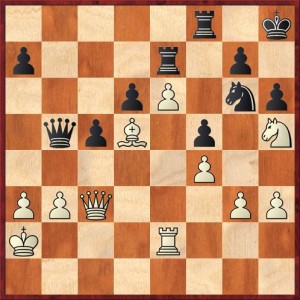
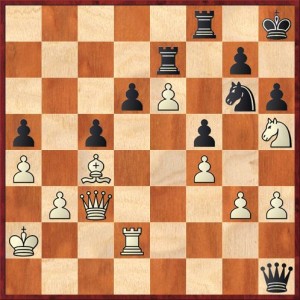
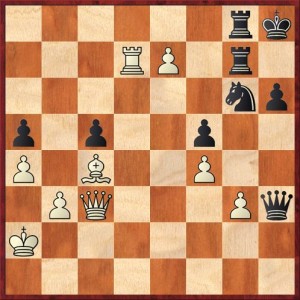
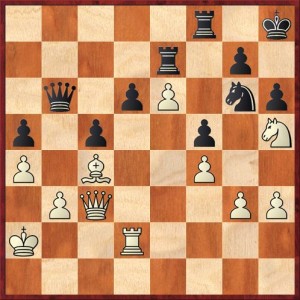
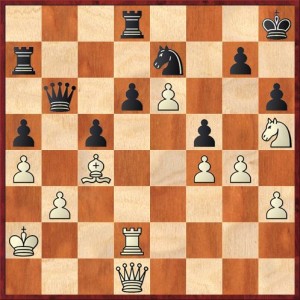
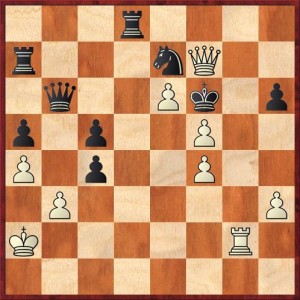
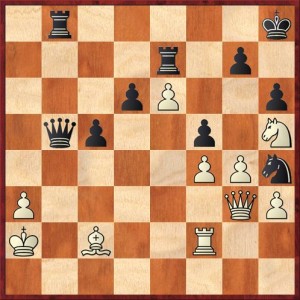



{ 5 comments… read them below or add one }
Time trouble is something I have tried hard to correct. It’s still a bit of a problem but hopefully less so than a couple of years ago. It’s an old trick but I mentally divide the time I have (which will either be the entire time for the game or the time for the first time control) by the number of moves I need to make (typically 40). For example, at my club we play 40/90 + 30 SD. In reality, it’s 40/85 with the 5-second delay but I figure 40/90 is close enough. That tells me I need to make approximately 13 moves every 30 minutes. It’s not a hard and fast rule; sometimes I have made 13 moves way before 30 minutes, sometimes I haven’t, but at least it tells me well in advance if I might be getting into time trouble.
I have also tried to get out of the habit of spending too much time on making a move “work.” It’s a very common problem with us chess players but we spot a combination, look at the various lines, and then realize our opponent has one continuation to refute it. We then spend a ton of time on the clock trying to make the move work, when in reality perhaps it just doesn’t. Having spent all that time, in a panic we try to find something else and play the first half reasonable move that comes to mind. I’m sure we’ve all done that many times but it’s a very inefficient use of the clock that can come back to haunt us later in the game when time is getting low.
I played a game against a class B player a couple of months ago. I was a pawn up with a nice position and my opponent was extremely low on time (something like 4 minutes to make 10 moves). I played a real flashy move that was designed to confuse him and make him panic. After letting go of the piece, I realized he had a nice way to win his pawn back and probably have a perpetual check to boot. Bizarrely, he just sat there…with his clock ticking…ticking…until he lost on time. After the game, I told him he had a way to win his pawn back and he said “Oh, I know” and showed me the correct move. I asked him why he didn’t play it and he said he wasn’t 100% sure about it and that he would rather lose on time than sully a nice game by blundering. I found that very interesting, especially as I know he has lost on time a couple of times since then. Perhaps he gets “paralysis from analysis” and is afraid of blundering because he hasn’t left himself long enough to think. Personally, I would prefer to take my chances on the board than the certainly of flagging!
Hi Matt,
I think your point about “trying to make moves work” is a really good one. I do a lot of that. I spent about 20 minutes in my last-round game trying to make a move work before deciding on something else. Fortunately, it was early in the game and I managed to play fast enough the rest of the way to avoid serious time trouble. (That game ended in a draw by repetition around move 35.)
The B-player sounds like an extreme case. To me, losing a game on time is the worst kind of sullying. This guy is in denial that the clock is part of the game.
I did lose a game on time by paralysis once. I had at least a minute left for the last move, and I thought, “This is easy, I can take my time and decide in less than a minute.” Then I got sucked in by some variations and before I knew it, my opponent was pointing at my flag! (I think it was still a flag, not a digital clock yet.)
On monday I played a game with exactly the same time control.
But I played the first 40 moves rather fast and badly, and then had enough time to defend an endgame the exchange and two pawns down!
In the end we made a draw when my opponent was down to 30 seconds and my position still totally lost. (But not obviously lost anymore, I had gotten the two pawns back …)
“I hope that you’ve all learned something from all this” — I have! Thank you.
The weeknight games at my club are 40/90 SD/20, so sort of an accelerated version of that time control. Everyone is most concerned about making move 40 but you have to be able to sail right through that and keep your concentration up. I see lots of people barely make move 40, spend 10 minutes on move 41, and then blunder horribly within in the next five moves.
Chess.com though a good site will lose its value due to unprofessional & Unethical behaviour & poor treatment to its members by Moderators (Grost & Dio).
{ 1 trackback }